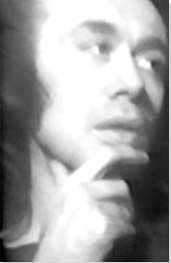Summary of Vito Acconci
Always adventurous in his decades-long career, Vito Acconci worked across mediums and disciplines, having started as an experimental poet before gaining attention in the art world through his boundary-pushing performances. Some of his early works used sex and eroticism to create new and at times uncomfortable viewing situations, challenging the art world's propriety, even as they also drew criticisms for their sometimes sexist overtones. Throughout, his evolving relationship with the viewer remained a central thread linking his varied artistic outputs, all of which re-imagine the artwork-viewer dynamic in participatory ways. In some of his early works, viewers became complicit as voyeurs, witness to Acconci's sexual drama, or were potentially subject to the artist's aggressive tactics. Later installation works let viewers manipulate the objects to activate them and fostered social interactions. While his 1970s pieces remain his best-known work, Acconci was also an accomplished designer whose studio came up with innovative proposals and iconic public architectural projects.
Accomplishments
- Acconci was not content with creating art objects for the public's neutral consumption in a traditional art-viewing context. Instead, he instigated situations, installations, and participatory contexts that broke through the typical public-private separation in society.
- Through sexuality and even aggression, the artist pushed his art into a new level of intensity and affective involvement, sometimes with provocative gestures, such as by masturbating underneath the floorboard on which viewers walked, and sometimes with startling vulnerability in laying bare his abjection and desires. Beyond sex as pornographic exposure, his work centered on his complicated psyche as a male subject within social environments.
- Acconci drew on Conceptual Art to interrogate language, its unstable signifying structure, and potential beyond everyday communication. He used his body and sometimes video as a basis for these early investigations. In so doing he also became a pioneer in Performance Art and Video Art.
- Acconci's use of his body explored what the art historian Elise Archias characterizes as the "concrete body" in art, that is, its inherent construction of embodiedness (inseparable, in fact, from language). His video work stands out especially for its foregrounding of the medium as a technology that mediates and relays images of the body and its underlying subjectivity, as well as the use of language as a tool for manipulation and the creation of a heightened atmosphere. His interactive installations can be considered a precursor to Relational Aesthetics of the 1990s.
- Later in his career Acconci designed installations and public space projects that invited audience participation and fostered interactions between passersby, all done with an understanding of how space and politics, including global geopolitics, intertwined.
The Life of Vito Acconci
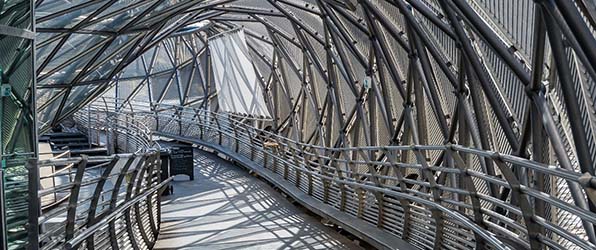
The multiple possibilities of audience involvement, whether physical, psychic, or emotional, were key to Acconci's artistic propositions from the start. As he moved away from Performance, his installation and public art projects invited hands-on involvement of the audience. The multipurpose Murinsel in Graz, Austria remains an iconic design that still functions to this day as a creative hub.
Important Art by Vito Acconci
Following Piece
One of Acconci's best-known works, Following Piece (1969) was the artist's early foray into themes of voyeurism, agency, and the public/private separation. In this game-like activity performed on the streets of New York City for nearly a month, the artist followed the same instructions everyday: "Each day I pick out, at random, a person walking in the street. I follow a different person every day; I keep following until that person enters a private place (home, office, etc.)."
The process varied in length, lasting anywhere from a couple of minutes and up to several hours, depending on the subject he chose each day. Acconci documented the activity by taking notes while following the individuals. For practical reasons, he did not carry a camera, and no photographs were taken of the performance. However, the final work exhibited in the gallery did incorporate staged photographs. Acconci explained, "It doesn't count unless there's a photograph. Art magazines deal with images. So I thought, I have to have photographs of Following Piece."
The act of following random individuals can be associated with danger. It certainly was voyeuristic and designed to make the viewer uncomfortable with the power dynamic between the artist and his unknowing subjects. Yet the scheme created by the artist also required him to give up a certain degree of agency: "I am almost not an 'I' anymore; I put myself in the service of the scheme." The performance based on predefined parameters, as well as the moderation of the artist's agency, puts this work within the lineage of Performance Art, Conceptual Art, and Fluxus in the 1960s, even as its involvement of the public and more aggressive overtone anticipated 1970s Performance Art and what the art historian Amelia Jones calls Body Art: work that makes use of the artist's body as a medium.
The work reveals a thread that will be dominant throughout Acconci's career: his persistent exploration and blurring of the public and private boundaries. Conceived as part of a public exhibition wherein artists were invited to create performance and conceptual work on the streets of New York, Following Piece signals the artist's interest in examining the power dynamic and erotics of human relations and encounters in ways that had until then not been addressed by other artists, at least not in such an explicit manner. It also played a significant role in the artist's early development before he branched out into further photographic activities, and experimentations with video art.
Activity - New York, various locations
Remote Control
In the performance Remote Control, Acconci and his companion Kathy Dillon sat in two wooden boxes in separate rooms. The set up included a monitor in front of each of them, which allowed them to see and hear one another. The viewer could see the pair on separate channels. Throughout the performance, Acconci and Dillon attempted to interact and respond to one other, as if their communication were unmediated.
Acconci stated that his aim was to "control the girl's mental framework and behavior - lead her to perform particular actions on herself inside her cramped private space. I will be constantly talking and using my body in an attempt to manipulate her." In the performance, he instructed Dillon to tie herself up with a rope, urging her to think of the rope as his own body wrapping itself around her. Initially, Dillon complied, but later she reacted to these manipulative tactics and asserted her own will.
As Acconci used language and gestures to manipulate and assert domination over his subject, Remote Control brings to mind questions of power dynamics between a male artist and his female subject that have, in fact, been inherent in the use of live models in art history. Similar to Following Piece (1969) but more explicit and layered, the work has sexual and voyeuristic implications, including for the viewer: what the artist describes as "private activity for two persons, in two enclosures" is passively consumed by an audience through a different monitor. The isolation of the couple and the reliance on technology as the only means of communication emphasizes the manipulative potential and danger associated with media technology as isolation chambers. While the title of the work refers to the artist's "remote control" of Dillon, it also implicates the viewer watching them as if on a television channel, anticipating more contemporary displays of power dynamics and manipulation of subjects such as on reality television.
Dillon and Acconci were living together at the time, and they collaborated on several performance pieces in the early 1970s including Applications (1970) Pryings (1971) Conversions I, II and III (1971) and more.
Two-channel video installation
Seedbed
Acconci's most iconic and notorious performance. The artist set up a wooden ramp halfway across the empty Sonnabend Gallery space, and then crawled under the ramp, concealing himself from gallery visitors. While occupying the confined space under the floor, Acconci masturbated repeatedly and shared aloud his sexual desires and fantasies with the audience. When visitors entered the gallery space, the artist would hear their steps, which fueled him to vocalize his unfiltered thoughts and desires, prompting the audience to react.
Seedbed deals with a central theme in Acconci's art, challenging the boundaries between the public and the private spheres and pushing further his exploration of voyeurism, desire, and power relations. By performing what is regarded as a private and intimate act in a public space, he attacked public norms, especially in an art gallery, a seat of modern high culture. By vocalizing his sexual desires, Acconci also brought his inner sexual-psychological landscape out in the open, in a cultural context where most people had been conditioned to keep theirs private.
The art critic and curator Germano Celant equates Seedbed with failed coitus: the artist dreams of an impossible penetration, which is transmitted to the audience through the floor. His action disrupted the regular art-going experience, jolting visitors out of their presumed neutrality in approaching art - but within an atmosphere of uncertainty and discomfort, if not menace, pushing at the edge of personal boundaries. From today's perspective, the gender identification, sexuality, and personal history of each audience member would inevitably have been a significant part of how the work was received, whether, for example, as provocation or harassment.
Seedbed can be understood within the context of his artwork exploring human relations around this time, not only in sexual or intimate relationships, but also the implicit, underlying dynamics of the public sphere, including between artist and viewer. Whereas his previous work often implicated his viewers as voyeurs, this performance explicitly turned the table on the audience, who could not see Acconci. They were unable to confirm what exactly he was doing under the floor or even whether he was there at all times.
Over time, Acconci developed an ambivalent attitude toward the work: "Seedbed might have made my career, but it also destroyed it, because nothing could live up to that, especially once you bring shock... People got to know me as someone who masturbated under a floor."
In 2005, another pioneer of performance art, Marina Abramovic performed a variation of Seedbed as part of the performance Seven Easy Pieces (2005) at the Guggenheim Museum in New York.
Performance/Installation - Sonnabend Gallery
Theme Song
Continuing with his disruption of the typical artist-viewer dynamic such as in Seedbed, in Theme Song the artist attempts to seduce the viewer. In the video, Acconci creates a casual and intimate atmosphere. He cozily lies on the floor of the living room, smokes cigarettes, and plays songs on the tape recorder. Through the camera, he is face to face with the viewer talking directly to them. He sings different "theme songs" by the Doors, Bob Dylan, Van Morrison, Lou Reed and others. The songs serve as a framework for his monologue, and through the lyrics Acconci brings up love, loneliness, and desire, exposing his vulnerable inner self. While belittling the artist, the act also functions as a manipulative technique that builds a relationship with the viewer and draws them into the artist's yearnings ("You could be anybody out there, but there's gotta be somebody watching me. Somebody who wants to come in close to me," "I'll take care of you if you come into me," "I just need your body next to me"). The framing of the lyrics and his vocalizations of desire in an art context adds a level of ironic distance to the songs, even as his raspy and deep voice, one of his artistic trademarks, contributes to to the seductive element of the work, and the overall impact of the video.
Theme Song demonstrates how Acconci's work directly engages the viewer in ways that push at the boundaries of the "proper" art object. Drawing on sentimentality and emotions in pop songs, the artist uses vulnerability and manipulation to create a sense of intimacy, highlighting the manipulative potential of images and videos people consume daily. By seducing the viewer, the artist plays on and makes explicit the implicit dynamic of art exhibition, wherein artists vie for the viewer's attention and approval. In so doing, he can be understood to claim back some agency within the situation with humorous desperation.
Video (black and white), sound
Where We Are Now (Who Are We Anyway)
Between 1974 and 1979, Acconci's artistic production focused on installations that usually incorporated sound and/or video. Moving from explorations of the more personal and erotic dynamics of individual encounters in previous work, Acconci turned the Sonnabend Gallery into a model public space, a kind of democratic meeting point where one can have an open exchange of ideas, with all of its possibility and limitation within the gallery space.
The artist closed off the main interior and painted its wall black, leaving a long corridor that extended to the windows of the gallery. The corridor contained a long, narrow wooden plank that served as a table with eight stools on each side. The table continued out of the window, turning it into a diving board, three stories above West Broadway. Acconci hung a speaker above the table, and the audience could hear the artist calling a meeting to order. The audio resembled a community meeting, with sound calling on different names and muffled voices from different speakers. The ominous phrase "Now that we know we failed" could be heard over and over, emphasizing previous failures at this community table - and perhaps the difficulty of any truly democratic participatory model. The diving board, jutting outside into the air, may also be understood to speak to this ambivalence. While the diving board can represent a dive into the action, a kind of leap of faith, suggests performance art scholar Frazer Ward, it can also be interpreted as a plunge into brutal reality ("walking the plank").
Scholar Judith Russi Kirschner also points to a new use of language that emerged in Acconci's installations, one that goes beyond the inclusion of audio recordings: "It is a linguistic system in which everyday objects, while retaining their everyday meaning, are transformed and become carriers of additional meaning, signifying potential use within the specific context Acconci has placed them." Kirschner notes that Acconci's use of ready-made objects differs from that of Marcel Duchamp, who altered the original function and meaning of everyday objects and transformed them into art. Instead, Acconci's table and chairs maintain their conventional function, but also mark the space as a meeting place for communal action. The objects are no longer props; they carry a symbolic meaning that helps transform the space from an art gallery to a community meeting.
Installation (wooden table and stools, painted wall, 4-channel audio) - Sonnabend Gallery, New York
Instant House
Four framed U.S. flags form a cross on the floor. At their center is a swing hanging from the ceiling. The flags are attached to a central wooden framework that is connected by cables to the swing in the center. When a person sits on the swing, they activate a mechanism that lifts the flags up, and forms the walls of the house. The flags have strategic cut-outs that serve as the door and windows of the house. The outer walls of the erected house reveal the USSR flag, which cannot be seen by the person sitting on the swing. Thus, the occupant is unaware of the contrast between the interior and exterior: they are inside U.S. walls while raising the USSR flag to the other members of the audience. Once the person gets up from the swing, the flags fall to the floor, returning to their original position.
Turning his attention to architecture and space, Acconci incorporated the motif of the "house" in several sculptures in the 1980s. Instant House is an interactive work that deals with the house as a contradictory space--public on the outside and private on the inside, mediated by human-made walls. The artist playfully dismantles the comfort and security associated with the home by making a collapsible structure with political implications. In a way, he fools the participant, who is unaware of their active participation in Cold War politics, as they erect the USSR flag. Curator Linda Sherer notes that the artist maintains political ambiguity: "Acconci renders the national symbols of the USSR and USA interchangeable, neutralizing the symbolic language of political institutions. The piece indicates his reluctance to adopt ideological orthodoxy." It may also be understood to link together shared concerns around the home, comfort, and security that link everyday citizens of both countries and ask further questions about what constitutes a house, even what architecture is.
Instant House closely relates to the concept of the "decorated shed" espoused by architects Robert Venturi, Denise Scott Brown, and Steven Izenouir in the book, Learning from Las Vegas (1972). They rejected modernist architecture, and instead took inspiration from the architecture of the Las Vegas strip, characterized by billboards, neon signs, and superficial decorations. Through signage, Las Vegas architecture centers around the commercial function of the building. The sign becomes such a dominant feature that it is hard to separate the building from its signage. Acconci utilized the concept of the "decorated shed" by using the flags (a form of signage with especially loaded symbolisms) as the dominant feature of the home. At the same time, the artist rejected the consumerist ideology that is emblematic of Las Vegas architecture by using signage to evoke political questions and discussions. Unlike his previous work employing video and audio to interact with the audience, this piece makes use of a built environment that audience members can manipulate, anticipating participatory art and Relational Aesthetics of the later decades. It also demonstrates his interest in design and architecture.
Self-erecting architectural unit (flags, wood, cables and pulleys)
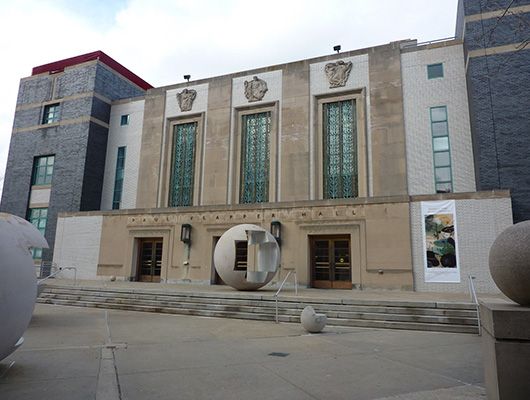
Extra Spheres for Klapper Hall
The public installation consists of seven spheres in various sizes (from 36 cm to 3.2 meters in diameter) that populate the Klapper Hall Plaza in Queens College, New York. The idea for the installation came from an existing element of architecture: two concrete spheres at the entrance of the English Department building. Different niches were cut into the new spheres and lighting was added into the interior. The spheres transform the plaza by creating new possibilities for interaction: they can serve as new passageways, individuals or groups can sit in them, and the interior lighting allows the activity to continue after sunset.
The installation at Klapper Hall is characteristic of the projects pursued by the Acconci Studio (founded in 1988). Together with his team, Acconci focused on projects for public spaces with the goal of opening these spaces to new kinds of interactions, whether solitary, intimate, or communal, continuing one of the key threads running through his career.
Fiberglass, granite finish, light - Permanent installation, Queens College, New York
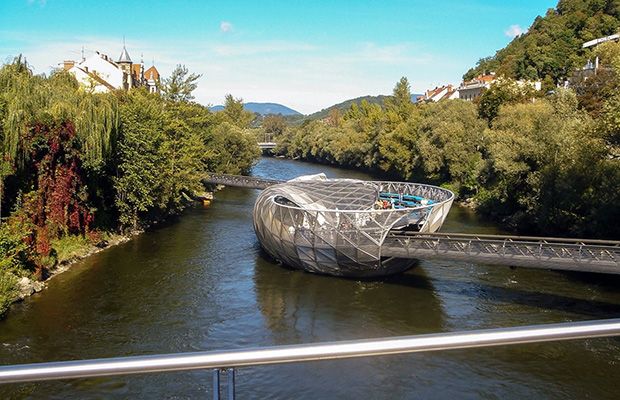
Murinsel (Mur Island)
Murinsel is a human-made floating island located in the middle of the river Mur in the Austrian city of Graz. The island also serves as a link between the two sides of the city, connecting both riverbanks by two footbridges. At a length of 47 meters, the large steel construction is reminiscent of a giant seashell, or even a UFO when observed from a large distance.
The idea for the project came from curator Robert Punkenhofer, a Graz native, and was realized by the Acconci Studio as part of the cultural initiative, "Graz 2003: Cultural Capital of Europe." Acconci explained the motivation behind Punkenhofer's concept: "The reason he thought that was because his young son still lived in Graz, and he thought that children had no reason to go down to the river."
The island had to fulfill three functions: serving as a theater, a café, and a playground. With these conditions in mind, the Acconci Studio developed the idea of "a bowl that morphs into a dome that morphs into a bowl." The bowl warps itself into a dome to create both indoor and outdoor spaces, seamlessly weaving together the different spaces without separating walls: the terraced bowl serves as an amphitheater while the section under the dome functions as a café. Finally, the twisted spaces in between create the playground.
Although it was originally intended as a seasonal project, the island soon became a permanent fixture due to its great success with audiences. It stands for an architecture that enhances interactions and relationships within the public sphere. Today it has become a popular city landmark and also functions as a creative hub for the Graz design scene.
Steel, glass, rubber, asphalt, water, light; 1,052 sq. m. - Graz, Austria
Biography of Vito Acconci
Childhood
Vito Hannibal Acconci was born in Bronx, New York, the only son to Italian immigrant parents. He was named after his grandfather, who was ill at the time but later recovered. Growing up, he resented his Italian heritage: "As a child I hated my Italian background; I wanted to be an American. Later at high school dances, for example - I hated introducing myself; it was as if no one could hear me I had to spell things out: 'No, not Peter - V-I-T-O.'"
Raised Roman Catholic, he attended Catholic schools from kindergarten to his graduate studies, explaining that "there wasn't a woman in my classroom between kindergarten and graduate school." As an adult, Acconci abandoned the Catholic faith, ironically citing his Catholic education as one of the main reasons for disassociating himself from religion.
Still, the artist recalled his upbringing as happy: his interest in the arts, especially writing, was encouraged and cultivated by his parents. His father, who "lived in a world of puns" inspired his early love of language, teaching him the playfulness and flexibility of words. Unfortunately, Acconci's father died in 1962, unable to see his son's artistic achievements.
Early Training and Work
Acconci earned his BA with a major in literature from Holy Cross College in Worcester, Massachusetts in 1962 after which he completed his MFA in writing at the University of Iowa. Upon completing his studies in 1964, Acconci returned to New York City to pursue a career as a poet. There, he first encountered the works of Jasper Johns that left a profound impact on him. Influenced by Johns, Acconci's poetry focused on the synthesis between language and the artistic use of space.
From 1962 to 1968, Acconci was in a short-lived marriage with artist Rosemary Mayer. Through Rosemary, he befriended her younger sister, poet Bernadette Mayer. During the second half of the 1960s, he and Bernadette published the groundbreaking mimeographed magazine 0 - 9, named after a series of works by Johns. Rosemary was also involved in the project, and occasionally contributed to its production. Even though the avant-garde publication existed for three years and had only six issues, it brought together leading figures of experimental poetry and conceptual art.
In 1969, Acconci began his transition from poetry to visual arts. His earliest works were photographs, which recorded his different actions, such as jumping, bending, or throwing. These laid the groundwork for Acconci's performance pieces, which he sometimes combined with video and film. The performances usually employed his body as a key element, and at times tested the artist's physical and mental limits - as well as the viewer's comfort level. In Trademark (1970) he bit his body all over, in Claim (1971) he blindfolded and barricaded himself in a small space and, with a crowbar and metal pipes, violently defended it from intruders, and, most famously, in Seedbed (1972) he masturbated while hidden under the gallery floor. Art historian Frazer Ward pointed out that these artistic experiments all share a common thread, which will continue to occupy the artist throughout his career: "Acconci characteristically shuttled between public and private realms so as to disallow any clear distinction between them." In most of these early performances, the private realm was expressed through corporeal and sexual activities, which expressed both masochistic and sadistic tendencies and turned the performances into provocations that elicited the audience's affective reactions.
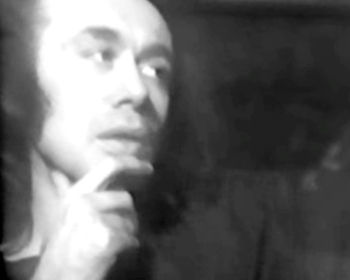
Some of these body works were done in collaboration with Kathy Dillon, his partner at the time. The couple lived together for five years, and their collaborations usually explored the power dynamics of their relationship. In some instances, Acconci wanted to assert domination and control over Kathy. His tactics varied from physical force to sexual innuendo and emotional manipulation. The performances were personal but also planned, making it hard to decipher between art and life, and describe the genuine nature of their relationship. Once they parted ways, Acconci once again channeled his emotions through performance: in Line-Up (1973) he played various roles in front of the audience in order to process the end of his relationship with Kathy.
The development of Performance Art in the 1960s, and Acconci's artistic practice specifically, is linked closely to Minimalism and Conceptual Art. With the cultural climate of Feminism and increasing artistic awareness of gender and body politics, the artist was also conscious of his role as a male performer: "Performance in the early seventies was inherently feminist art. I, as a male doing performance, was probably colonizing it." The influence of Feminist Art and theory may underlie his choice of subject and performance parameters, which grappled with questions of sexuality, power, and gender relations. While the artist laid bare his sometimes vulnerable and abjected self, some of these performances were also criticized for their sexist elements and overtones that, especially from today's vantage point, lacked nuance in dealing with personal boundaries and trauma awareness.
Mature Period
In 1974, Acconci stopped performing, and between 1974 and 1979, he created installations and sculptures that would often incorporate video and audio. This shift signified the artist's desire to take the focus off himself and concentrate on the viewer, and their interaction with the artwork: "Whereas in the beginning I could see my stuff as 'person meets person', gradually I came to realize it was 'art viewer meets art star.' I had always been against this notion of cult, or art as a religion, or art as sacred object. My shift, then, was from a kind of psychological self to a sociological self."
By 1980, he completely removed his presence from his work, and began creating installations and sculptural pieces that he called 'self-erecting architecture.' Throughout the 1980s, Acconci explored the idea of the home, and the house became a frequent motif in his work. For Acconci, the house is a space filled with contradictions: it is associated with security, protection, and sanctuary, but it can also be seen as a restrictive space that is controlled by a repressive paternal authority.
In 1988, Linda Sherer curated the exhibition 'Public Places' at the Museum of Modern Art, New York, which focused on Acconci's sculptures and public art projects. The exhibition represented a turning point for Acconci's career as a designer of public projects: "Before that show, nobody asked me to propose projects for public places." Seizing momentum, that same year, he opened the collaborative enterprise Acconci Studio, signaling his transition from art to architecture and design.
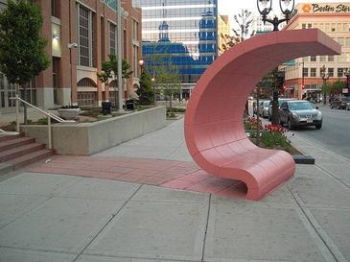
The idea behind the studio was to bring in people with expertise that would help him realize more ambitious architectural projects. Some of his first collaborators at the studio were John Taiguri and Robert Price, whom he met in 1979 after they completed graduate school in architecture at Columbia University. Taiguri and Price were already close to Acconci and had helped him realize some of his early sculptures. From the outset, Acconci wanted the studio to function as a collaborative effort: "they didn't simply carry out my ideas; rather talking with them reshaped and reformed my idea. Now I was thinking because of them and through them."
By establishing the studio, Acconci could focus on his primary goal, creating public projects, that would engage broad audiences and would reconnect art with life. Their commissions varied from commercial entities to institutions and public spaces.
Late Period
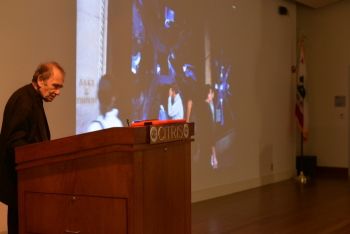
By 2000, Acconci Studio expanded to a total of eight collaborators including Acconci himself. Around the same time, he met his second wife Maria, over forty years his junior, while giving a commencement speech at Pratt Institute. The couple got married, and later worked together at Acconci Studio. During the 2000s, the studio realized one of their most successful projects, the human-made island Murinsel (2003) in Graz, Austria. They also presented ambitious project proposals that remained unrealized. One example was a proposal for a new World Trade Center (2002) that presented a futuristic tower full of holes.
In 2016, in celebration of their 40th anniversary, MoMA PS1 organized the exhibition VITO ACCONCI: WHERE WE ARE NOW (WHO ARE WE ANYWAY?), a survey of Acconci's early career. A year later, Acconci passed away at the age of 77. He is survived by his wife Maria Acconci.
The Legacy of Vito Acconci
As a pioneer of Performance and Video Art, Acconci influenced a generation of younger artists, such as Tania Bruguera, Mike Kelley, Laurie Anderson, and Matthew Barney.
With Acconci's work as a starting point, in her seminal essay "Video: The Aesthetics of Narcissism" (1976), art critic Rosalind Krauss argued that the aesthetics of narcissism emerge with the rise of the medium of video. Analyzing the work Centers (1971), in which Acconci filmed himself pointing to the center of a television monitor for the duration of 20-minutes, Krauss argued: "A line of sight that begins at Acconci's plane of vision and ends at the eyes of his projected double. In that image of self-regard is configured a narcissism so endemic to works of video that I find myself wanting to generalize it as the condition of the entire genre." In today's context, her critique can be applied much more broadly to our entire online communication and media structure. Acconci's artistic experiments from the late 1960s and early 1970s, which documented the mundane and challenged the boundaries of the private and public realms, foresaw the technological potential that changed the way we communicate and consume content in the era of social media, with all of its entangled affective relations and manipulations. Hence, his early works still maintain the potency and the social relevance they had at the time of their conception. Their tactics, sometimes heavy-handed and sexual, remain provocative.
The importance - and notoriety - of these early works overshadowed the artist's later accomplishments and collaborative work at Acconci Studio. While this proved to be a source of some frustration for the artist, it has not impeded him from building a successful career as an architect and designer. Today, Acconci Studio continues its work as a design collective, honoring the work and vision of their founder.
Influences and Connections

-
![Jasper Johns]() Jasper Johns
Jasper Johns -
![Robert Venturi]() Robert Venturi
Robert Venturi -
![Robert Rauschenberg]() Robert Rauschenberg
Robert Rauschenberg - Jean-Luc Godard
- Rosemary Mayer
- Bernadette Mayer
- Kathy Dillon
- John Tagiuri
- Maria Acconci
-
![Marina Abramović]() Marina Abramović
Marina Abramović -
![Sarah Lucas]() Sarah Lucas
Sarah Lucas ![Paul McCarthy]() Paul McCarthy
Paul McCarthy- Juan Francisco Elso
Useful Resources on Vito Acconci
- Vito Acconci (2002)Our PickBy Frazer Ward, Mark C. Taylor, Jennifer Bloomer
- Vito Acconci: Writings, Works, ProjectsBy Gloria Moure
- Vito Acconci (1991)By Amnon Barzel, Jeffrey Kipnis
- Vito Acconci: Public Places (1988)Our PickBy Linda Shearer
- Vito Acconci: A Retrospective 1969-1980 (1980)By Judith Kirshner
- Acting Out: The Body in Video: Then and Now (1994)By Julia Bunnage
- Art becomes Architecture becomes Art: A Conversation between Vito Acconci and Kenny Schachter, moderated by Lilian Pfaff (2006)
- Dialogues in Public ArtOur PickBy Tom Finkelpearl
- The Concrete Body: Yvonne Rainer, Carolee Schneemann, Vito AcconciBy Elise Archias
- No Innocent Bystanders: Performance Art and Its AudienceBy Frazer Ward
 Ask The Art Story AI
Ask The Art Story AI